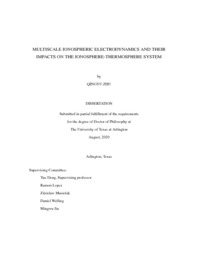
ATTENTION: The works hosted here are being migrated to a new repository that will consolidate resources, improve discoverability, and better show UTA's research impact on the global community. We will update authors as the migration progresses. Please see MavMatrix for more information.
Show simple item record
| dc.contributor.advisor | Deng, Yue | |
| dc.creator | Zhu, Qingyu | |
| dc.date.accessioned | 2022-01-20T18:09:12Z | |
| dc.date.available | 2022-01-20T18:09:12Z | |
| dc.date.created | 2020-08 | |
| dc.date.issued | 2020-08-11 | |
| dc.date.submitted | August 2020 | |
| dc.identifier.uri | http://hdl.handle.net/10106/30164 | |
| dc.description.abstract | In this dissertation, multiscale ionospheric electrodynamics at different latitudinal regions and their impacts on the ionosphere and thermosphere (I-T) system have been studied in three aspects. Firstly, impacts of the vertical neutral dynamics on the dayside low- and mid-latitude thermosphere have been evaluated using a non-hydrostatic model, Global Ionosphere Thermosphere Model (GITM), for the first time. It is found that the upward neutral wind increases the F-region neutral density, which plays an important role in balancing for the neutral density reduction associated with the divergent meridional wind in the equatorial region. The divergent meridional wind contributes to the formation of the equatorial thermosphere anomaly. Meanwhile, acoustic waves triggered by the vertical ion-neutral coupling processes are generated in the simulation. Secondly, this dissertation greatly advances the statistical knowledge of small-scale and mesoscale structures in high-latitude electrodynamical forcings, which is still lacking to date. Better understanding on small-scale and mesoscale structures in high-latitude electrodynamical forcings can improve the estimation of Joule heating, which is a critical pathway for the electromagnetic energy from the magnetosphere to deposit into the I-T system. On the one hand, the correlation between the electric field and the electron precipitation has been systematically quantified unprecedentedly. The overall anti-correlation results in a significant depression of Joule heating on the dusk side. On the other hand, the relationship between the field-aligned currents (FACs) and electric fields has been studied. It is found that strong FACs do not necessary correspond to strong electric field on small scale and mesoscale. Nevertheless, mesoscale FACs have a non-negligible contribution to Joule heating. Thirdly, efforts have also been made to improve high-latitude electrodynamical forcing specifications and estimations of Joule heating. First, a new empirical model, ASHLEY, has been established based on measurements from the Defense Meteorological Satellite Program satellites. As compared with most existing empirical models, new features of ASHLEY include improvements in specifications of soft electron precipitations and electric field variabilities. Moreover, by coupling the electron precipitation component of ASHLEY (ASHLEY-A) into GITM, a real event study illustrates that advanced soft electron precipitation specifications can remarkably improve the data-model comparison of the F-region neutral density during geomagnetic storms. Finally, potential applications of the boundary-oriented binning method in the high-latitude empirical modeling have been explored. It is found that the boundary-oriented binning method can address the deficiency of the commonly used static binning method and further improve Joule heating estimations. | |
| dc.format.mimetype | application/pdf | |
| dc.language.iso | en_US | |
| dc.subject | Ionospheric electrodynamics | |
| dc.subject | Ionosphere-thermosphere system | |
| dc.title | Multiscale ionospheric electrodynamics and their impacts on the ionosphere-thermosphere system | |
| dc.type | Thesis | |
| dc.degree.department | Physics | |
| dc.degree.name | Doctor of Philosophy in Physics and Applied Physics | |
| dc.date.updated | 2022-01-20T18:09:12Z | |
| thesis.degree.department | Physics | |
| thesis.degree.grantor | The University of Texas at Arlington | |
| thesis.degree.level | Doctoral | |
| thesis.degree.name | Doctor of Philosophy in Physics and Applied Physics | |
| dc.type.material | text | |
| dc.creator.orcid | 0000-0002-4003-4104 | |
Files in this item
- Name:
- ZHU-DISSERTATION-2020.pdf
- Size:
- 13.87Mb
- Format:
- PDF
This item appears in the following Collection(s)
Show simple item record


